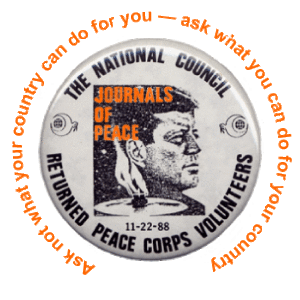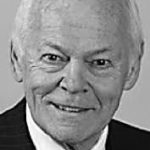Why The Journals of Peace? Tim Carroll Tells Us (Nigeria)
The Journals of Peace
Making it happen
by Tim Carroll (Nigeria 1963-66)
In 1988, as the first Director of the National Council of Returned Peace Corps Volunteers (NCRPCV), now the National Peace Corps Association, I felt a considerable part of my mandate was to bring our disparate numbers together, to gather us up to celebrate those feelings we had in common. A number of special events given under my tenure accomplished this in varying degrees of success, but none held the hearts of Peace Corps family as did the Journals of Peace.
As the 25th anniversary of the death of President John Kennedy — the founder and much-loved hero of early
Volunteers — approached, I made a call to St. Matthew’s Cathedral, the church that had been the site of JFK’s funeral service, and asked if we might have a memorial Mass that would include not only the traditional Showing of the Colors but a procession of flags, carried by returned Volunteers, representing all their countries of service. The priests quickly agreed.
Then in a conversation with John Coyne (Ethiopia 1962–64), he mentioned how many PCVs had kept journals while overseas and suggested we might have RPCVs read from their journals for twenty-four hours before the memorial Mass at the Cathedral.
When this proved to be impossible at St. Matthews, I called Connecticut Senator Chris Dodd (Dominican Republic 1966–68)) and asked if it might be possible to stage such a vigil in the Capitol Rotunda. Holding a 24-hour vigil in the Rotunda of the U.S Capitol had never happened before, (at that time the Capitol Rotunda was open to the public from 9:00 am to 4:30 pm) but the good Senator made it happened.
RPCVs respond to the invitation
Next, we put out a call to RPCVs around the world and asked them to come to Washington, D.C. on November 21, 1988, and remember John F. Kennedy and their service for America in the Peace Corps by reading from their journals. So began the Journals of Peace.
The response from the RPCV community was overwhelming and was almost more than the nascent staff at the NCRCV could handle. That staff included Kitty Thuermer (Mali 1977–79), Jeff Drumtra (Niger 1978–80), Mark Hallett (Philippines 1983–85), Laura Byergo, (PC/Staff Burndi), Geoffrey Greenwell (Zaire 1986–87), and Michael McGirr (Sierra Leone 1977-80) who was the Journals of Peace Director. Many others donated their time, including Dennis Grubb (Colombia 1961–63), who handled the press for the event.
Returned Volunteers from across the nation, hearing about the opportunity of reading a minute or two from their journals, signed up in the hundreds and quickly filled the 24-hour time slots with their three-minute readings.
The Journals of Peace
From mid-afternoon on November 21, 1988, until it was time for the Mass to begin the following day, Volunteers of all sizes, shapes, and ages read inspiringly from their journals or retrieved from their memories, fragments for what had been for them the defining moments of their young lives. Through the night it continued each story, each anecdote another piece of the message: when you are working for others your own life is enlarged, enhanced, and made memorable.
We gave the final time slot to then-Director of the Peace Corps, Loret Miller Ruppe, who, while not a Returned Volunteer, had in her eight years as head of the agency, come to reflect the attributes Volunteers respected, among them that peace was more important than politics.
A service of remembrance
When Loret finished her presentation, there was a seamless transition to the cathedral. There the first Director of the Peace Corps, Sargent Shriver; his deputy, Bill Moyers; and Father Theodore Hesburgh, a former Peace Corps adviser and president emeritus of President of Notre Dame, were among the officials presiding over the service.
Over 1,500 attended this service of remembrance at St. Matthew’s where Father Hesburgh, would remark in his homily, “I think if Kennedy were standing here today, his hair probably white like mine, he would say, ‘You are the people that took the best message that I gave to the world. You understood what it meant to serve.’”
Bill Moyers recalled the 1960s in his tribute to Kennedy. “I hear the sounds of crowds cheering and cities burning, of laughing children and weeping widows, of nightriders, nightmares and napalm, of falling barriers and new beginnings and animosities as old as Cain and Abel . . . . But something survived those years which bullets could not stop. An idea survived, embodied in the Peace Corps . . . Out there, John F. Kennedy might say, is the new frontier.”
A handful of RPCVs — Peggy Anderson (Togo 1962–64), John Coyne (Ethiopia 1962–64), Paul Tsongas (Ethiopia 1962–64) and Roger Landrum (Nigeria 1961–63) — were asked to say a few words in the Cathedral which acted as a Coda to the Journals of Peace.
In addition to being a Peace Corps Volunteer in Nigeria from 1963-65, he was also the Peace Corps Country Director in Pakistan, Poland and Russia between 1990 and 1995. For a decade of work with Eye Care, Inc. in Haiti, Tim received the first Shriver Award for Humanitarian Service in 1986. After founding the Office of Protocol for the Department of Justice, (1997-01), Tim Carroll retired to his family farm in Michigan. He continues his interest in international affairs and travels widely.


I had never heard of this! Wow- now I want to read The Journals of Peace. We should make a national archive of RPCV Journals of Peace and have it online for anyone in the world to read. It could be organized by country and year and program (Fish Heads, Math and Science Teachers, TEFL, Public Health ect). What a perfect Third Goal opportunity.
I will go to amazon now to see if I can buy a transcript of the original JOP.
Thanks John for sewing the seeds of peace.
Great Idea!
I met my future wife at the Journals event. Paula Hirschoff. She was Kenya (68-70) and I was Nepal (68-70). We met there. I read on Monday morning — along with Ed Branson (from my Nepal group). Paula and her friend Judith Kelly read that night. Later Paula and I rejoined — Senegal 05-07. We then led the PC reform campaign from 07-15. We loved our PC experiences and are proud of our campaign to reform the PC.
I went searching on-line for a statement that I recalled Tim Carroll had made in a 1994 interview with the Chicago Tribune and found his Journals of Peace posting that I must have missed. The statement was, “A lot of them thought they were coming over here to change Russia.” Tim took on awesome responsibility as the CD for Russia but always had time to greet me and other volunteers with that infectious energy when we came to Moscow. It’s great to read this from Tim.